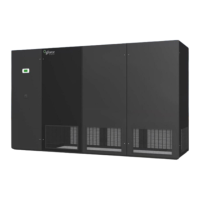44
All automatic control is disabled but the safety switches remain functional. Simply slide the
manual switches to energize the fan, compressor(s), humidification, reheat and other functions
(as applicable).
The fan speed of the Electronically Commutated (EC) plug fan motor can be adjusted from 0 to
10 volts DC by adjusting the potentiometer at the left of the Fan Speed switch. The fan speed
will increase 10% of the fan base speed for each one (1) volt adjustment (e.g., one (1) volt
equals 10% speed). At ten (10) volts the motor is at full speed.
Plug Fan Current Sensing Switch
Unit with backward curve plenum fans with electronically commutated (EC) motor (plug fan)
use a current sensing relay (CT) as a safety to alarm when the air flow is unusually low or no
air flow. See section 3.17 Plug Fan Current Sensing Switch for more information regarding
switch adjustment.
Wiring Diagrams
Every Data Aire evaporator, condenser, condensing unit or fluid cooler comes with a wiring
diagram. These diagrams are ladder type schematics intended for service personnel. The
intent is to allow the technician to understand the wiring details associated with the electrical
components and how they interface with the controls as well as peripheral equipment
(including secondary heat exchangers).
The wiring diagram in the evaporator will indicate field interface terminals to the secondary
heat ex- changer. The internal wiring of the secondary heat exchanger is found on a separate
diagram which can be found on the inside cover of the heat exchanger electrical box. Both
diagram types are also placed inside the shipping/warranty packet secured in the evaporator
section.
Electronic Expansion Valve Optional
The Electronic Expansion Valve (EEV) is optional for this unit. This high efficiency feature
provides an EEV in place of the standard Thermal Expansion Valve (EEV). The EEV controls
superheat through the dap4 controls by actively measuring suction pressure via a transducer
attached to the suction line and suction temperature via a thermal transducer strapped to the
suction line. The EEV actively adjusts the orifice size and resulting mass flow of refrigerant to
maintain the superheat setpoint. The EEV maintains more stable system balance and is more
energy efficient. With variable capacity systems, an electronic expansion valve is the solution
to handle refrigerant mass flow variations.
Electrical Connection to EEV
The Electric Expansion Valve (EEV) uses an electrical cable assembly with a DIN type
connector to interface with EEV valve stator. The connector is indexed by one large blade
connection so that the connector can only properly mate one way. When it is necessary to

